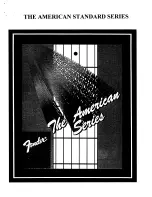
stewmac.com
Ideally, the neck block has remained square to the side as-
sembly . The neck will meet the top at a subtle 1-1/2° angle .
When they are square, a minimum of hand-fitting is needed
to get the proper neck set (the angle of the neck/body joint) .
However, it’s not uncommon to find that some adjustment
is needed in setting the neck . Use the following information
to adjust the angle of the neck in any direction .
The neck joint is a mortise-and-tenon joint . The tenon is
the precision-cut extension on the end of the neck, and the
mortise is the neck block recess which fits it . A dovetail joint is
glued together using a tenon with angled sides; the bolt-on
joint has a straight-sided tenon and requires no glue (except
under the fretboard where it extends over the body) .
The neck angle is controlled by the shape of the neck heel as
it contacts the sides of the body . It is not determined by the
fit of the mortise-and-tenon joint . (In fact, correctly setting
the angle on a dovetail neck actually loosens the dovetail
joint, which is later re-tightened by using a wooden shim .)
The neck heel sets the neck angle
Understanding the neck joint
Removing wood from the top or bottom of the neck heel
tips the neck forward or back . Removing from either the
bass or treble side changes the neck’s angle in relation to
the center of the bridge .
The two roughly triangular surfaces on either side of the
tenon are called the “cheeks” of the neck heel . These cheeks
are machined flat, but the guitar sides they contact are not
flat: the guitar has a slight curvature at the neck block . Most
of the handwork in fitting a neck is cutting away the inner
part of these cheeks to fit this curvature . Only the outer
edges of the heel make contact with the body , and these
edges set the neck angle
(illustrated on next page)
.
The contact area of the heel is an area about 1/8" to 3/16"
wide around the outer edges of the bass side, treble side,
Fitting the neck to the body
and bottom of the cheeks . Mark this area on the heel with a
pencil . Using a sharp chisel, remove wood from the remain-
ing inner area up to the tenon
(pictured on next page)
.
After under-cutting the cheeks this way, you should have
a neck fit that is very close . Still, you may need to remove a
little wood from the outer contact edges to adjust the neck
alignment . Removing wood from the upper part of the neck
cheek edges will raise the neck (decrease the angle), remov-
ing from the bottom will lower it (increase the angle) . Taking
wood from either side will move the neck in that direction .
The measurement we want is
X
— the amount of
wood to remove from the heel to change the neck
angle so that a straightedge laid on the frets will be
flush with the top of the bridge .
A
= How far the straightedge falls below the top of
the bridge . In this example: 1/8" ( .125") .
B
= The heel length from the fretboard bottom to
the heel cap . In this example: 3-13/16" (3 .812") .
C
= The distance from the neck/body joint to the
saddle . In this example, that’s at the 14th fret, and
C
= 11-5/16" (11 .312") .
X
=
A
x
B
÷
C
In this case, those numbers are .125" x 3 .812" ÷
11 .312" = .042" . So in our example
X
= .042" which
is between 1/32" and 3/64" . This is the amount to
remove at the bottom of the heel .
Here’s the way to determine how much wood must
be removed from the cheeks for the correct neck
angle at the bridge . Always remove wood gradually
and check your progress frequently . A little adjust-
ment goes a long way! Our example measurements
below are based on the scale length of this guitar:
25 .4 inches .
KIT TIP: Understanding neck angle geometry
A
X
B
C
Straightedge
.125"
3 .812"
11 .312"
.042"
23
Summary of Contents for 5295
Page 1: ...Dreadnought Acoustic Guitar Kit 5295 Assembly Instructions www stewmac com ...
Page 2: ......
Page 39: ......


































